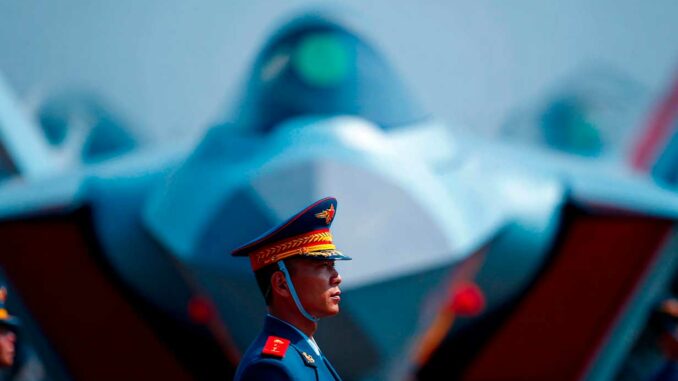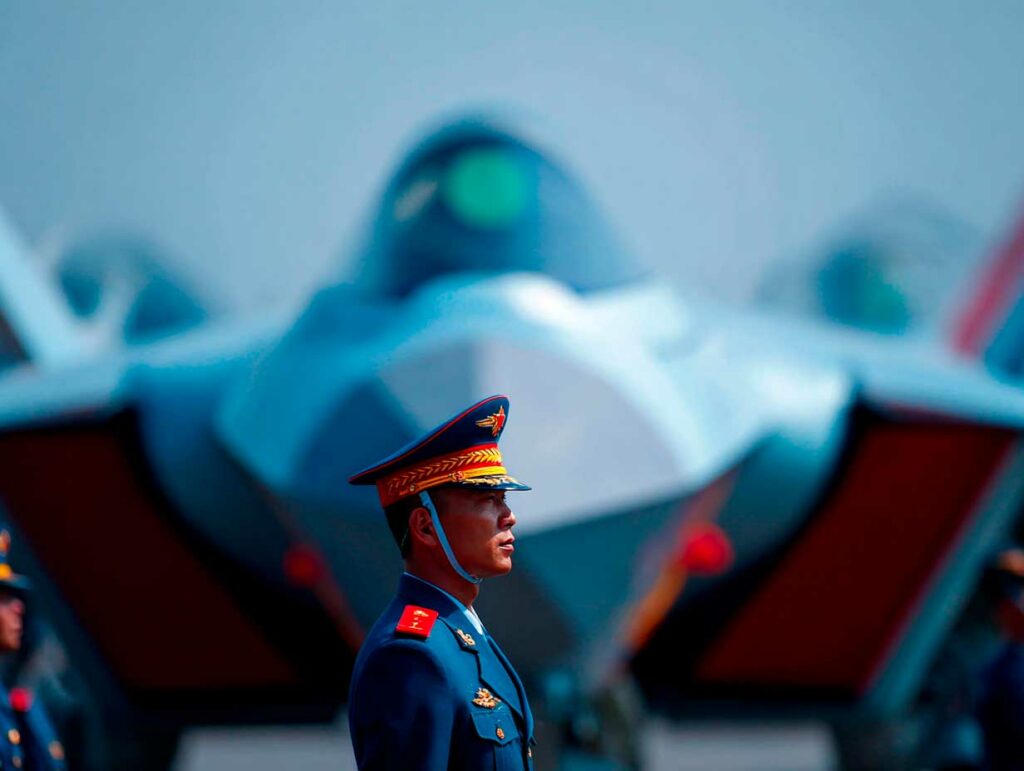
In China, large military-technology groups are joining forces to boost air, naval, space, and cyber defense. Comprehensive analysis.
In summary
China has established a defense industrial ecosystem in which large state-owned enterprises (such as Aviation Industry Corporation of China (AVIC), China Aerospace Science & Industry Corporation (CASIC), and China Shipbuilding Industry Corporation (CSIC)) cooperate closely with private actors, universities, and research institutes. This civil-military fusion is accelerating developments in aviation (stealth fighters and drones), naval (aircraft carriers, destroyers), space (satellite constellations, BeiDou navigation) and cyber technology. The exchange of data, components and know-how between companies creates a powerful leverage effect. This national model contrasts with the American ecosystem (segmented, private-private) and the European ecosystem (multi-country, less integrated). Geostrategically, China’s rise is changing regional and global balances, with implications for security and the global technology supply chain.
The Chinese industrial model: integration and technology sharing
The organization of “military-civil fusion”
The concept of military-civil fusion (融合军民) is central to China’s industrial strategy. It aims to bring together civilian companies, state-owned groups, and the military (People’s Liberation Army – PLA) to pool technologies, skills, and production chains. According to studies, large state-owned companies such as CASIC and AVIC collaborate with private start-ups and academic institutions to develop weapons systems.
This integration enables civilian companies to produce components (radars, embedded software, composite materials) for military platforms, while benefiting from public R&D. The result is an accelerated cycle of innovation.
Sharing between major companies and sector specialization
In China, the major groups divide up the sectors: AVIC (aeronautics), CSIC/CSSC (shipbuilding), CASIC (missiles, space), Norinco (land weapons). They operate joint ventures between themselves and with private players. Technology sharing is organized via common platforms, research consortiums, and system integrators.
For example, an airborne radar developed by AVIC can be adapted to a CSIC ship, or a satellite from the Chinese space agency can serve as a data relay for drones manufactured by an AVIC subsidiary. This cross-sector coordination is a strategic advantage.
An ecosystem supported by public authorities
The Chinese state directs funding, military orders, and standardization choices. The crossover between the civilian and military sectors allows for increased volume and lower costs. The US Department of Defense’s ranking of Chinese military companies (list 1260H) mentions more than 50 Chinese companies linked to defense. This shows the scale and relative transparency of the Chinese system to international observers.
Technological advances by sector: air, naval, space, and land
Air: fighters, drones, and engines
In the air sector, China has moved from imports to domestic development. The AVIC Chengdu Aircraft Corporation group is developing the Chengdu J-20 stealth fighter and collaborating with other subsidiaries to produce MALE/HALE drones.
Associated companies are working together on engines, composite materials, and avionics, resulting in more technologically autonomous squadrons. Synergy between AVIC, the Chinese Academy of Aeronautical Sciences, and private companies is reducing development times.
This approach is narrowing the gap with American and European platforms, while reducing dependence on exports of key technologies.
Naval: aircraft carriers, destroyers, submarines
At sea, CSIC and CSSC shipyards are cooperating with other groups to design 10,000-ton destroyers, new-generation aircraft carriers, and nuclear submarines. The integrated ecosystem facilitates the sharing of naval technologies with other sectors (e.g., aerospace composite materials).
The ability to mass-produce and multiply platforms qualifies as regional maritime superiority. For example, China has commissioned more destroyers than the United States in a given period of time, reflecting the speed of the model.
Space: constellations, navigation, and data relays
Space is another key area. The China Aerospace Science & Technology Corporation (CASC) group leads the BeiDou Navigation Satellite System program. This space infrastructure, connected to drone and electronic warfare companies, enables a global, integrated sensor network.
Chinese companies are also exploiting the boom in picosatellites and microsatellites for image collection, electronic warfare, and network coverage. Sharing between space, electronics, and military companies ensures a rapid increase in capabilities.
Land: armored vehicles, AI, sensors, and networks
On land, industrial groups such as Norinco produce armored vehicles, light vehicles, and new-generation artillery systems. Innovation also comes from the coexistence of civilian players in AI, telecommunications, and sensors (e.g., Hikvision, Huawei) that feed military platforms.
Data networks, electronic warfare, ground drones, and autonomous systems benefit from the synergy between the civilian and military sectors. Coordination between arms companies and high-tech firms reduces the time it takes for new equipment to enter service.

Geostrategic impacts and comparison with the United States and Europe
Regional and global rise to power
The integration of Chinese companies into a unified system allows them to combine volume, speed, and competitive costs. This translates into rapid access to advanced platforms (stealth fighters, destroyers, satellite constellations) and leverage in the Indo-Pacific region.
This rise is changing the strategic balance: China’s neighbors, as well as the United States, must take into account a China capable of producing and deploying large-scale systems.
Comparison with the American ecosystem: privatization, competition, and separate chains
In the United States, the defense industry is dominated by private players (Lockheed Martin, Northrop Grumman, Boeing Defense) that are separate from the civilian industry. These players compete with each other, but cross-sector collaboration is less pronounced than in China. The chains are more segmented, and civil-military fusion is more limited.
Thus, the Chinese model is characterized by integrated economies of scale and more direct state control. This allows for shorter development cycles, but also greater centralization and less entrepreneurial flexibility.
Comparison with Europe: fragmentation, multinationals, and moderate budgets
In Europe, the defense industry is fragmented between countries (France, Germany, Italy) and transnational groups (Airbus Defense, BAE Systems). Collaboration is often linked to multinational programs (Eurofighter, SCAF) and is subject to longer lead times, shared budgets, and political complexities.
Compared to China, Europe lacks volume, national integration, and control: exchanges between the civil and military sectors are less extensive and production is slower.
Risks for global technology supply chains
The rise of this Chinese ecosystem is weighing on international supply chains, particularly in semiconductors, radars, optical sensors, and artificial intelligence. US sanctions against Chinese companies (adding Tencent and CATL to the list of companies linked to the military sector) illustrate this tension.
Challenges and limitations of the Chinese model
The challenge of advanced components and technological autonomy
Despite advances, China still depends on certain Western technologies (semiconductors, engine turbines, high-end composite materials). Sanctions and restrictions limit its access to these technologies. The national model must therefore accelerate innovation in these critical areas.
The scale of synergies vs. bureaucratic complexity
China’s integrated system, while powerful, can suffer from bureaucratic red tape, inefficiencies, and duplication. Coordination between hundreds of state-owned and private companies remains a challenge, especially in a fast-paced high-tech environment.
The issue of export credibility and global projection
While Chinese companies produce in large quantities, their export credibility is sometimes considered to lag behind that of Western leaders. Top-tier integrated systems (radars, stealth aircraft, aircraft carriers) continue to be evaluated in the field. The model must prove its long-term reliability to confirm its global credibility.
The future of the Chinese defense ecosystem
Towards a new generation of connected platforms
The coming years will see the rise of interconnected systems: swarm drones, autonomous weapons systems, tactical space networks, and naval and land platforms powered by artificial intelligence. The Chinese ecosystem is taking advantage of its integrated approach to accelerate this transformation.
Collaborative aerial robotics, intelligent naval co-production, and space constellations dedicated to military operations will become major areas of focus.
Towards increased global influence
With rapid industrial and technological integration, China is targeting not only the Indo-Pacific region but also a global role as a supplier of weapons, equipment, and defense systems. This poses a direct challenge to Western cooperation frameworks (NATO, AGS) and export standards.
Towards a new paradigm of technological competition
Competition is no longer just about the best platform, but about the best systems integration, speed of implementation, mass capacity, and technology-operational fusion. The Chinese ecosystem is building this paradigm.
The Chinese defense industry is not content to simply replicate foreign models: it is changing the rules of the game by integrating business, research, the military, and the nation into a coherent whole. Coordination between state-owned companies, private actors, universities, and research centers is giving rise to a robust ecosystem, ranging from aviation to space, and from naval to land. This model offers clear advantages in terms of volume, speed, and economies of scale, while posing major challenges to the West in terms of technology, exports, and strategy. The time has come to assess not only the platform but also the entire ecosystem in which it operates.
War Wings Daily is an independant magazine.